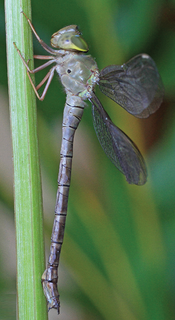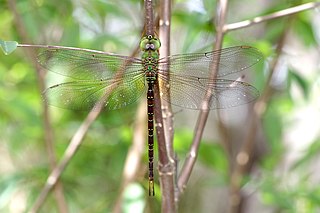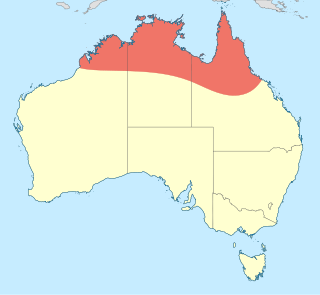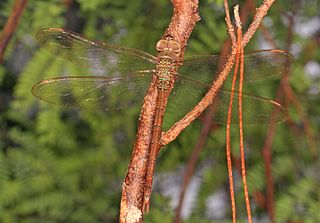Gynacantha africana is a species of dragonfly in the family Aeshnidae. It is found in Cameroon, Central African Republic, the Republic of the Congo, Ivory Coast, Equatorial Guinea, Gabon, Ghana, Nigeria, and Uganda. Its natural habitats are subtropical or tropical moist lowland forests and shrub-dominated wetlands.

Gynacantha is a genus of dragonflies in the family Aeshnidae. The females have two prominent spines under the last abdominal segment. This gives the genus name and the common name two-spined darners; they are also known as duskhawkers.

Gynacantha bullata, the black-kneed duskhawker, is a species of dragonfly in the family Aeshnidae. It is found in Burundi, Cameroon, Central African Republic, the Republic of the Congo, Ivory Coast, Equatorial Guinea, Gabon, Ghana, Guinea, Kenya, Liberia, Malawi, Nigeria, Sierra Leone, Tanzania, Togo, and Uganda. Its natural habitats are subtropical or tropical moist lowland forests and shrub-dominated wetlands. Gynacantha bullata is a very widespread species, however deforestation is a threat in parts of its range and the impacts of this needs to be monitored. At present, it is not thought that this will cause the global population to decline at a sufficient rate to qualify or nearly qualify the species for a threatened category under criterion A; therefore it is assessed as Least Concern.
Gynacantha immaculifrons is a species of dragonfly in the family Aeshnidae. It is found in the Democratic Republic of the Congo, Malawi, and Tanzania. Its natural habitats are subtropical or tropical moist lowland forests and shrub-dominated wetlands. It is threatened by habitat loss.
Gynacantha manderica is a species of dragonfly in the family Aeshnidae. It is found in Burundi, the Democratic Republic of the Congo, Ivory Coast, Ghana, Guinea, Kenya, Liberia, Malawi, Namibia, Nigeria, Sierra Leone, Somalia, South Africa, Sudan, Tanzania, Uganda, Zambia, and Zimbabwe. Its natural habitats are subtropical or tropical moist lowland forests, subtropical or tropical moist shrubland, and shrub-dominated wetlands.
Gynacantha nigeriensis is a species of dragonfly in the family Aeshnidae. It is found in Cameroon, the Republic of the Congo, Ethiopia, Ghana, Guinea, Nigeria, Sierra Leone, Uganda, Zambia, and possibly Tanzania. Its natural habitats are subtropical or tropical moist lowland forests and shrub-dominated wetlands.
Gynacantha sextans is a species of dragonfly in the family Aeshnidae. It is found in Angola, Cameroon, the Democratic Republic of the Congo, Ivory Coast, Equatorial Guinea, Ghana, Guinea, Nigeria, Uganda, and Zambia. Its natural habitats are subtropical or tropical moist lowland forests and shrub-dominated wetlands.
Gynacantha usambarica is a species of dragonfly in the family Aeshnidae. It is found in Kenya, Malawi, Mozambique, South Africa, Tanzania, and Zimbabwe. Its natural habitats are subtropical or tropical moist lowland forests and shrub-dominated wetlands.

Gynacantha villosa is a species of dragonfly in the family Aeshnidae. It is found in Botswana, Burundi, Central African Republic, the Democratic Republic of the Congo, Ethiopia, Kenya, Malawi, Mozambique, South Africa, Tanzania, Uganda, Zambia, and possibly Burkina Faso. Its natural habitats are subtropical or tropical moist lowland forests and shrub-dominated wetlands.

The papillose blenny is a species of chaenopsid blenny found in the western Atlantic ocean. It can reach a maximum length of 4.5 centimetres (1.8 in) TL. The specific name honours the ichthyologist Charles C. G. Chaplin (1906-1991).

Gynacantha dravida, also known as Indian duskhawker or brown darner, is a species of dragonfly in the family Aeshnidae. It is found in India and Sri Lanka.

Gynacantha rosenbergi is a species of dragonfly in the family Aeshnidae, known as the grey duskhawker. It inhabits still waters and is found in New Guinea, Indonesia, through parts of northern Australia, as well as islands in the south Pacific.

Gynacantha dobsoni is a species of dragonfly in the family Aeshnidae, known as the lesser duskhawker. It inhabits ponds and swamps and is found in northern Australia.

Gynacantha kirbyi is a species of dragonfly in the family Aeshnidae, known as the slender duskhawker. It is found in northern Queensland, Australia, the Maluku Islands, Tanimbar and New Guinea.

Gynacantha mocsaryi is a species of dragonfly in the family Aeshnidae, known as the paddle-tipped duskhawker. It is found in northern Queensland, Australia, the Maluku Islands and New Guinea.

Gynacantha nourlangie is a species of dragonfly in the family Aeshnidae, known as the cave duskhawker. It inhabits pools in caves in northern Australia.

Gynacantha bayadera, parakeet darner or small duskhawker, is a species of dragonfly in the family Aeshnidae. It is found from India to South China and northern New Guinea. This is a crepuscular species which probably breeds in forested swamps and marshy areas, or in forest pools.

Gynacantha mexicana, the bar-sided darner, is a species of darner in the dragonfly family Aeshnidae. It is found in Central America, North America, and South America.

Gynacantha nervosa, the twilight darner, is a species of darner in the dragonfly family Aeshnidae. It is found in the Caribbean Sea, Central America, North America, and South America.

Gynacantha millardi, is a species of dragonfly in the family Aeshnidae. It is found from India and Sri Lanka. This is a crepuscular species which probably breeds in forested swamps and marshy areas, or in forest pools.












